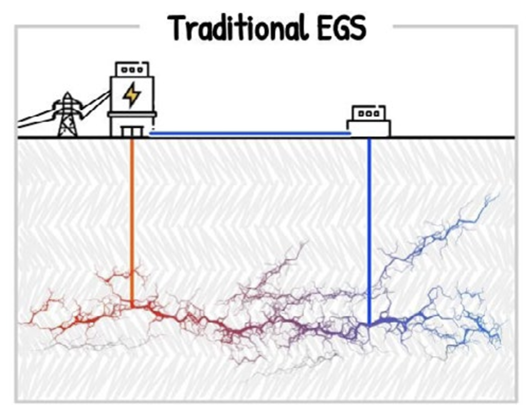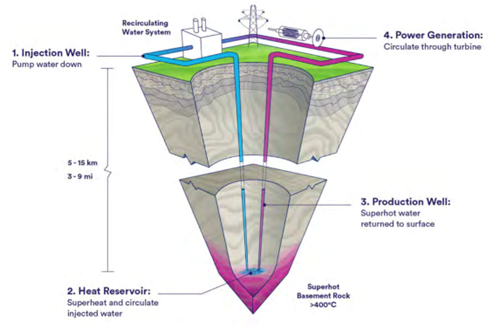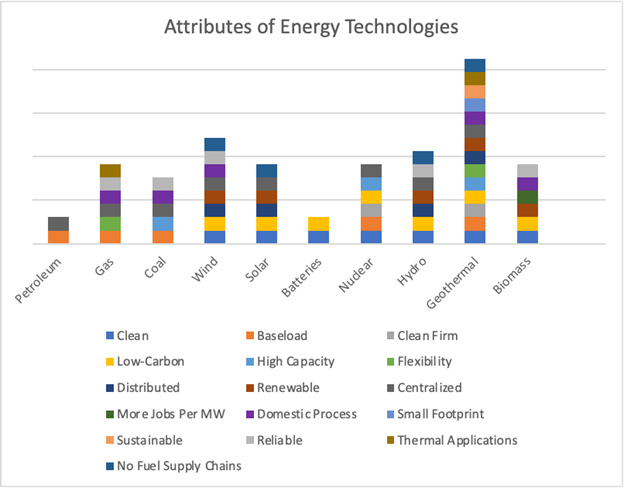Geothermal Power Production
Geothermal power production involves using the heat from the earth to generate electricity. In one process, water far below the aquifers we use for drinking are drawn to the surface from underground reservoirs. This water is very hot because of the natural heat produced by the Earth’s mantle. We use this hot water to produce steam and this steam is used to drive the turbines which produce electricity.
All geothermal power production involves three primary requirements – heat, water and permeability (a measure of how porous the rock is).

Conventional Hydrothermal Systems (CHS): Also called traditional geothermal systems, these resources are generally close to the surface and often have various surface manifestations associated with them, such as hot springs, fumaroles or steam vents. CHS have the necessary combination of porosity, heat and water to produce a developable geothermal resource.
Examples of companies include BHE Renewables, Calpine Energy, Coso Operating Company, Cyrq Energy, and Ormat Technologies.

Engineered/Enhanced Geothermal Systems (EGS): Some systems have the appropriate amount of heat and water, but initially lack the permeability (porousness) to access the water effectively. EGS is a means of increasing the water connectivity in these systems by using thermal, hydraulic, or chemical stimulation to create a fracture system within the rock. Examples of companies using this technology include Fervo Energy, Sage Geosystems, and Ormat Technologies.

Advanced Geothermal Systems (AGS) also known as Closed-Loop Geothermal: Closed-loop systems don’t require a constant source of water. Instead closed-loop systems circulate a man-made fluid through a sealed piping system to absorb through conduction and transport the heated liquid man-made fluid to the surface where the steam spins a turbine. The cooled liquid is then cycled through the closed-loop piping system to be reheated. There is no interaction between the subsurface environment and the liquid in the pipes. Examples of this type of technology include the Greenloop by GreenFire Energy and the Eavor-Loop by Eavor Technologies.

Supercritical Hot Rock (SHR): Deeper hot rock systems with temperatures over 400 degrees Celsius contain the potential to produce significantly more energy than conventional hydrothermal systems. By injecting water through deep injection wells, the water is heated to the point where it becomes “supercritical”, allowing it to pass more easily through fractures and bringing more energy to the surface. SHR systems can use EGS or AGS closed-loop technologies but the main difference is the depth at which SHR accesses. SHR may descend up to 20 kilometers to get closer to the natural heat produced in the Earth’s mantle. Examples of companies include AltaRock Energy, Quise Energy, and XGS Energy.

|
Common Energy Transition Terms |
Energy Technology Examples |
|
Renewable |
Geothermal, Solar, Wind, Biomass, Hydro |
|
Clean |
Geothermal, Solar, Wind, Hydro, Nuclear |
|
Clean Firm |
Geothermal, Nuclear |
|
Baseload |
Geothermal, Nuclear, Natural Gas, Coal, Petroleum, Biomass, Hydro |
|
Low-, No- or Zero-Carbon |
Geothermal, Solar, Wind, Hydro, Nuclear |
|
High Capacity |
Geothermal, Nuclear, Natural Gas |
|
Flexible |
Geothermal, Natural Gas, Electrical or Thermal Storage, Small Modular Nuclear |
|
Distributed |
Geothermal, Solar, Wind, Hydro, Small Modular Nuclear |
|
Centralized |
Geothermal, Coal, Gas, Nuclear, Solar, Wind, Hydro, Petroleum |
|
Reliable |
Geothermal, Nuclear |
|
More Jobs Per MW |
Geothermal |
|
Small Footprint |
Geothermal, Nuclear |
|
Domestic Development Process |
Geothermal, Natural Gas, Coal, Hydro, Petroleum |
|
Domestic Manufacturing Supply Chain |
Geothermal, Natural Gas, Coal, Hydro, Petroleum |
|
No Fuel Supply Chains |
Geothermal, Solar, Wind, Hydro |
|
No Critical Mineral Supply Chains |
Geothermal, Hydro |
|
Sustainable |
Geothermal |

- Binary Cycle: The most common type of power plant used to develop electricity from geothermal resource. In a binary cycle plant, the fluids from the geothermal reservoir don’t come into direct contact with the turbine at any point. Instead, the fluids pass through a heat exchanger with a secondary fluid. This fluid generally has a lower boiling point than water and can therefore generate power from lower temperature resources than dry steam or flash plants can. Examples of this type of system include the Organic Rankine Cycle and the Kalina Cycle.
- Dry Steam: This type of production is used in systems where the fluids are already primarily steam. This steam is brought to the surface and used directly to drive the turbine. The reservoirs needed for this type of production are relatively rare and generally only found in certain areas of the world, such as the Geysers in California or Larderello, Italy.
- Flash Steam: Flash steam production pumps high-pressure fluids from deep underground into a low-pressure tank, which causes the fluids to “flash” into vapor and drive a turbine. Remaining fluids are often flashed a second time in another tank to extract even more energy.
- Supercritical CO2 (sCO2): A turbine system that maintains sCO2 working fluid in a supercritical state through the whole thermodynamic cycle. Demonstrations show this technology increases overall efficiency from <10% to mid 20% range.
- Thermoelectric: Thermoelectric generators (TEG) are solid state devices that convert heat directly into electricity, functioning in much the same way as a heat engine. TEGs produce electric voltage when there is a different temperature on either side of the material.

- Clean Air Task Force: https://www.catf.us/resource/superhot-rock-energy-a-vision-for-firm-global-zero-carbon-energy/
- Idaho National Laboratory: https://inldigitallibrary.inl.gov/sites/sti/sti/3589644.pdf
- National Renewable Energy Laboratory: https://www.nrel.gov/geothermal/technologies.html
- Pacific Northwest National Laboratory: https://www.pnnl.gov/geothermal-energy
- Sandia National Laboratories: https://energy.sandia.gov/programs/renewable-energy/geothermal-research/
- Southern Methodist University Geothermal Lab: https://www.smu.edu/Dedman/Academics/Departments/Earth-Sciences/Research/GeothermalLab
- U.S. Department of Energy: https://www.energy.gov/eere/geothermal/geothermal-technologies-office
- U.S. Energy Information Agency: https://www.eia.gov/energyexplained/geothermal/geothermal-power-plants.php
- U.S. Bureau of Land Management: https://www.blm.gov/programs/energy-and-minerals/renewable-energy/geothermal-energy
- University of Texas Austin: https://energy.utexas.edu/research/geothermal-texas
- Why FORGE Works (IFP analysis): https://ifp.org/why-forge-works/
